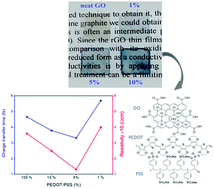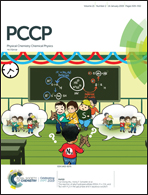Molecular orientation and femtosecond charge transfer dynamics in transparent and conductive electrodes based on graphene oxide and PEDOT:PSS composites†
Abstract
The conducting polymer, poly(3,4-ethylenedioxythiophene)–polystyrenesulfonic acid (PEDOT:PSS), is certainly one of the most important substitute materials for indium tin oxide in organic devices. Its metallic conductivity and transmittance bring favorable perspectives for organic photovoltaic applications. Although graphene oxide (GO) is not a good conductor, it can form high-quality thin films and can be transparent, and additionally, GO is an inexpensive material and can be easily synthesized. This study investigated how the conductivity of a composite film of graphene oxide (GO) and different amounts of PEDOT:PSS can be modified. The effects of GO:PEDOT:PSS composites with several PEDOT:PSS proportions were analyzed in regards to the composite molecular structure and ordering, charge transfer dynamics (in the femtosecond range), electrical properties and morphology. For the best conductivity ratio GO found with 5% PEDOT:PSS, a solvent treatment was also performed, comparing the resistivity of the film when treated with dimethyl sulfoxide (DMSO) and with ethylene glycol.



 Please wait while we load your content...
Please wait while we load your content...